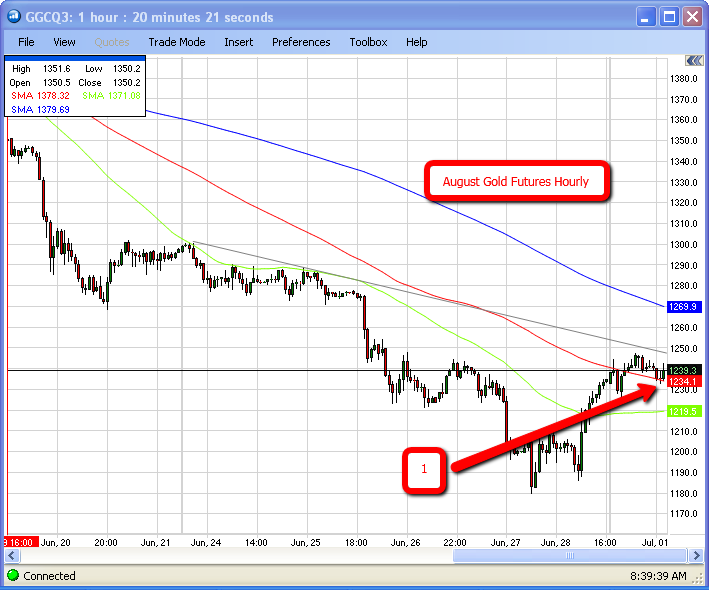| Banking District (Photo credit: bsterling) |
Los Angeles, Jul.2, daily stocks .- Each Week Longleaftrading.com will be providing us a chart of the week as analyzed by a member of their team. We hope that you enjoy and learn from this new feature. Weekly Gold Report (June 24th through June 28th).
The second quarter of 2013 came to a close with a decent rebound in the US Stock Indexes. A three day up-move was the result of favorable consumer spending, housing, and unemployment numbers. Despite the move up, it was not an easy week to predict market movement, nor was it a week to feel comfortable in a trade for more than a half day. This is because last week’s schedule of economic reports was punctuated daily by FED Members that now have the ability puppeteer global markets with one interview. Even though the FED decided to keep rates unchanged and maintain their Bond buying on a monthly basis (QE), the interviews that followed the decision had the potential to negate the initial response to the rate decision. Last week required the attention of traders each day as one FED Member after the next was asked about their thoughts on whether or not Ben Bernanke and Co. would begin to scale out of QE sooner or later. My opinion is that the scaling back has already begun.
A few years ago, the United States was virtually the only game in town when it came to the experimental QE programs. What we experienced was a steady drop in the US Dollar, and a steady rise in most foreign Currencies, US Treasuries, and Commodities across the board. Although it is not written about as much as the US Program, almost all other major Central Banks around the globe, including the ECB, SNB, PBOC, BOC, BOE, and others are now participating in similar programs.
Now that other global competitors of the US are easing, the impact that the US FED has on the Dollar and global markets is lessened. My thought is that over time, as more and more Central Banks ease, it gives the FED the best opportunity to unwind positions that have been accumulated over the years when they were the only game in town. It can be done in an orderly fashion as banks are buying and selling between one another over time. And I do not believe that this type of activity is exclusive to Currencies and Bonds. I believe it is happening in virtually all market sectors across the board.
Since the market crash a few years ago, big global banks have been stripped of their ability to proprietarily trade and control larger positions in major markets (see Dodd-Frank Act). I believe that the slack has been picked up by the Central Banks who now control the majority of the volume, which gives them the ability to accumulate and unwind positions between one another. This is the best way to keep the markets from ever going through any uncontrollable volatility. This may have to continue until all major markets show sustained results and until debts between nations are paid off……..it may be a while!
Of course, there will always be a few markets each year that will trade true and based on undeniable fundamental data, the way the Grains traded last year during the drought in the US. But I believe that financial markets, including global Currencies, Treasuries, Stock Indexes and Precious Metals will remain under the thumb of Central Banks until the dust settles around the globe.
This is not necessarily a bad thing, especially for retail investors. The major plus is that very few markets are going through the huge overnight and intraday reversals that were becoming very common a few years ago when prop desks were accumulating and dumping huge positions. Limit moves on the day of a major report were always a possibility, especially if there was unexpected news. These days, even Interest Rate Decisions barely have anyone concerned about big corrections because most markets are slower moving in comparison.
This controlled environment is helpful when it comes to trading technically and difficult when trading fundamentally. A majority of the work I do in the markets revolves around technical analysis anyway, so I do not mind the steadier market environment. Holding onto a position for the longer term and fundamental play can be a seriously difficult task that I would rather not have to sit through. I think for most traders, the better play is to look for technical breaks to trade and if the market gives you the ability to hold on for the long term, just do so with stop-orders that protect gains.
The Gold Futures showed some small signs of life at the end of last week, but even a respectable $60 bounce from last week’s low can be compared to the impact of throwing a deck chair from the sinking Titanic. To begin the week, the futures are consolidating around $1235 an ounce. On the 60 minute chart seen below, you will notice this is where the 100day Simple Moving Average comes into play (arrow #1). This area also represents a 50% retracement of the move down from the June 21sthigh to the June 27th low. Until Gold prices show me much more buying interest, I am not inclined to make any commitments to a longer term, upside move. I think traders can easily see nice gains by trading technically on an intraday or swing trade. Feel free to contact me directly if you would like to discuss these potential opportunities.



No comments:
Post a Comment